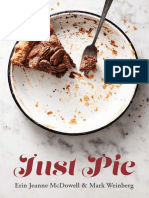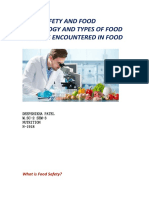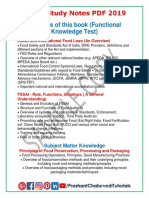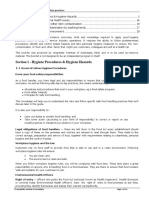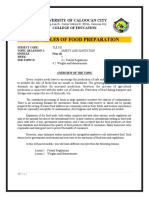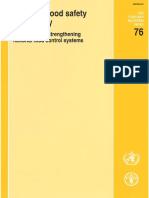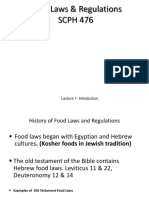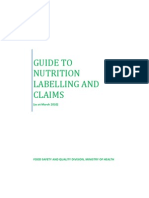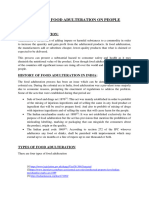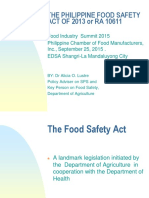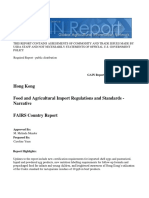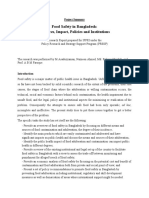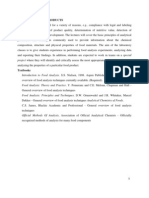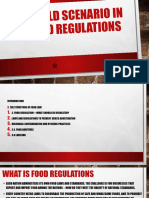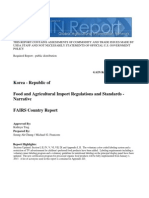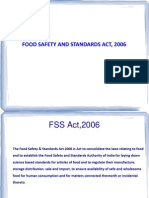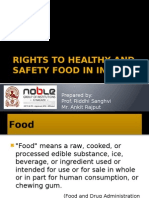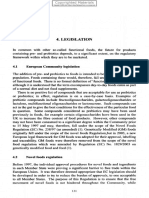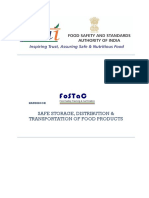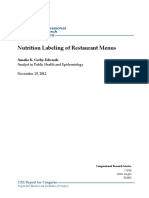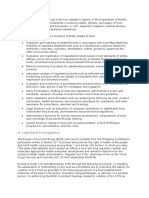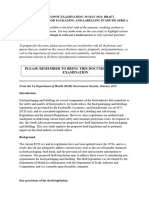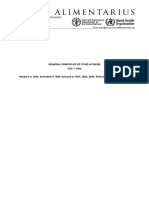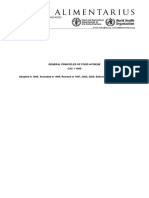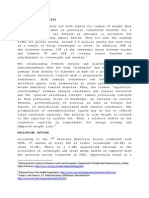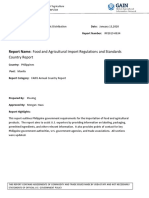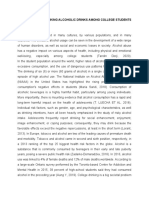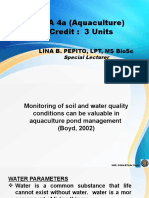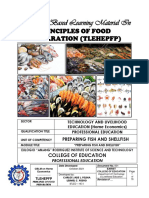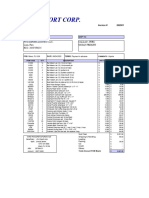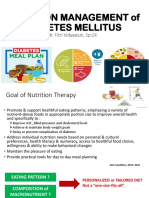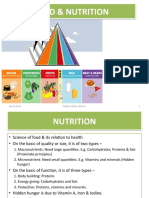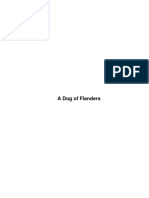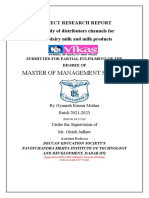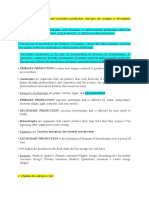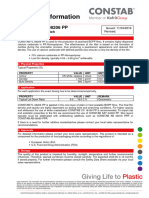Professional Documents
Culture Documents
Food Law and Regulations
Food Law and Regulations
Uploaded by
charlesOriginal Title
Copyright
Available Formats
Share this document
Did you find this document useful?
Is this content inappropriate?
Report this DocumentCopyright:
Available Formats
Food Law and Regulations
Food Law and Regulations
Uploaded by
charlesCopyright:
Available Formats
FOOD QUALITY AND STANDARDS – Vol.
I - Food Laws and Regulation - Radomir Lásztity
FOOD LAWS AND REGULATION
Radomir Lásztity
Department of Biochemistry & Technology, Budapest University of Technology &
Economics,Hungary
Keywords: Food law, food regulation, food additives, food act, food standards,
adulteration, chemical/microbial/environmental contamination, code of hygienic
practice, residue limits, health risks, nonobservable effect level (NOEL), food labeling,
harmonization
Contents
1. Introduction
2. The Structure of Food Law
S
TE S
3. Food Regulation—What Should be Regulated?
R
AP LS
3.1 Food Standards
3.2 Laws and Regulations to Prevent Gross Adulteration and Contamination
3.3 Microbial Contamination, Hygienic Practice
C EO
3.4. Chemical and Environmental Contamination
3.5 Food Additives
3.6 Labeling
4. Harmonization of Food Laws and Regulations at the International Level
Glossary
E –
H
Bibliography
Biographical Sketch
PL O
M SC
Summary
Every nation needs an effective food legislation and food control service to promote a
safe, honestly presented food supply, and to protect consumers from contaminated,
SA NE
adulterated, and spoiled foods. Generally the food law is divided into two parts: a basic
food act and regulations. The Act itself sets out broad principles, while regulations
contain detailed provisions. The principles or general provisions to be included in food
U
law are primarily: basic purposes and scope, definitions of basic concepts, inspection,
enforcement, biological and chemical contaminants, packaging and labeling, and
procedures for the preparation and amendment of the regulations for implementation of
the law. Food law is based on scientific studies. Harmonization of Food Law on the
international level is a worldwide trend from the late twentieth century.
1. Introduction
Every country needs laws to encourage the production of safe and wholesome foods,
and to prohibit the sale of foods that are unsafe or fraudulent. The growing population
has placed demands on agriculture for increased production. However, the increase of
agricultural production is connected with the wider use of chemicals. Protection of food
during transport and storage may require the use of chemicals, too.
©Encyclopedia of Life Support Systems (EOLSS)
FOOD QUALITY AND STANDARDS – Vol. I - Food Laws and Regulation - Radomir Lásztity
The centralized processing of foods in large quantities increases the chances of
contamination. There is an increasing demand for convenience foods, foods ready-to-
serve or which can be quickly prepared for serving. Because food additives are
commonly used in these foods, and because convenience foods are especially
susceptible to contamination, strict hygienic and safety precautions are needed.
Expansion of the food trade, both within countries and with other nations, needs
regulation not only at the national but also at the international level. In past centuries,
international trading in food took place with little, if any, government intervention, and
it was accepted that the food producers set their own standards and determined the
quality of food products offered to consumers. Many businesses were responsible and
took great care to protect the health of consumers. However, some dishonest traders
misused the unregulated markets to sell adulterated food. Such abuses led to
government involvement and over time to the enactment of food laws and regulations.
These laws and regulations, together with food control organizations, ensure the safety
S
TE S
of domestically produced, imported, and exported food products (see System of Food
R
AP LS
Quality Standards).
In the framework of this chapter, the principal requirements of food law and regulations
C EO
will be treated.
2. The Structure of Food Law
Generally, Food Law may be divided in two parts: (1) a basic food act, and (2)
E –
regulations. The Act itself sets out broad principles, while regulations contain detailed
H
provisions governing the different categories of products coming under the jurisdiction
PL O
of each set of regulations.
M SC
Sometimes food standards, hygienic provisions, lists of food additives, chemical
tolerances, and so on are included in basic food control law.
SA NE
For effective administration of and enlightened compliance with the basic food law,
detailed provisions are needed. In governments where there is a division between the
responsibilities of the legislative and executive branches, the legislative branch enacts
U
the basic law, while detailed regulations are elaborated and promulgated by the
executive agency or agencies responsible for administering the law.
Inclusion in the law of detailed specifications about food processing, food standards,
hygienic practices, packaging and labeling, food additives, and pesticides may make for
difficulties. Prompt revisions of regulations may become necessary because of new
scientific knowledge, changes in food processing technology, or emergencies requiring
quick action to protect public health. Such revisions can be made much more
expeditiously by executive agencies than by legislative bodies.
In some countries food standards are part of the regulations; in other countries they are
separate enactments. Regardless of whether they are included in regulations or are
separate, they become part of the enforcement structure, and are intended to implement
basic food law.
©Encyclopedia of Life Support Systems (EOLSS)
FOOD QUALITY AND STANDARDS – Vol. I - Food Laws and Regulation - Radomir Lásztity
Concerning the principles or general provisions to be included in basic food law, the
following points should be stressed:
• basic purposes and scope of the law
• definitions of basic concepts
• competence for implementation of the law
• inspection and analytical procedures and facilities
• enforcement, procedures for enforcement, penalties
• regulations for additives, pesticides, contaminants
• packaging and labeling
• procedures for the preparation and amendment of the regulations for implementation
of the law
The basic food law is intended to assure consumers that foods are pure and wholesome,
S
TE S
safe to eat, and produced under sanitary conditions. Generally, food law prohibits
importation and distribution of food products that are adulterated, or have labels that are
R
AP LS
false or misleading in any context.
The proper implementing of such a law encourages fair trade practices through
C EO
compliance with the basic provisions of the food law. This protects the honest
manufacturer and dealer against unfair competition. It also stimulates development of
the food industry, because quality control along sound scientific lines tends to promote
better consumer acceptance of foods.
E –
H
An important part of the food law is the definition of terms such as food, natural food,
PL O
imitation food, food additives, adulteration, and food fraud, pesticide residues, food
contaminant, and so on.
M SC
According to the US Food, Drug, and Cosmetic Act, a food is illegal (adulterated) if:
• It contains added poisonous or deleterious (harmful) substances that may render it
injurious to health.
SA NE
• It contains a natural, poisonous, or deleterious substance which ordinarily renders it
injurious to health.
• A raw agricultural product contains residues of pesticides not authorized by the US
U
Environmental Protection Agency (EPA), or in excess of tolerances established by
regulations of the US EPA.
• Any part of the food is putrid or decomposed.
Another example of strict definitions is that basic food law should determine the exact
content of offenses, which can give rise to penal action. Such offenses may be:
• deliberate adulteration of food products
• production or marketing of foods containing prohibited or unauthorized substances
• fraudulent use of labels and trademarks
• failure of foods to satisfy standards laid down by law
• violation of hygienic requirements, and so on
3. Food Regulations—What Should be Regulated?
©Encyclopedia of Life Support Systems (EOLSS)
FOOD QUALITY AND STANDARDS – Vol. I - Food Laws and Regulation - Radomir Lásztity
As mentioned earlier in this chapter, regulations implement basic food law. Food
regulations generally cover the following:
• general regulations
• food standards
• food hygiene
• food additives
• pesticides
• veterinary drug residues
• food packaging and labeling
• food advertising
The general regulations include detailed regulations for guidance of those who enforce
food law, regulations concerning official actions, such as making inspections, collecting
S
TE S
samples, making decisions about serious infractions, and the disposition of seized lots of
food. To this group of general regulations also belong regulations concerning licenses
R
AP LS
(permits); if firms and/or specific foods must be registered, the regulations should
specify conditions and requirements. Regulations concerning imported foods should
cover all aspects of the handling of imported foods. It is impossible to make an
C EO
overview of all the types of regulations; the above example hopefully will give readers
an idea about fields covered by general regulations.
3.1. Food Standards
E –
H
In every country, standards are an important part of the regulation of food production
PL O
and food trade. Food standards and standardization are treated in other contributions to
this series (see System of Food Quality Standards; History of Food Quality Standards;
M SC
Basic Concepts of Food Standards; National Standards; Regional Standards; and
International Systems of Food Quality Standards).
3.2. Laws and Regulations to Prevent Gross Adulteration and Contamination
SA NE
Laws and regulations are still needed to prevent gross adulteration and contamination.
Although the forms of gross adulteration and contamination of foods (e.g., diluting milk
U
with water, adding foreign matters to spices, use of harmful dyes or chemicals to mask
defects of quality, and so on) are rare, in developed countries in particular, the
adulteration of fruit juices with lower value fruit varieties, or of instant coffees with
cereal and malt-based ingredients have occurred in the late twentieth century.
3.3. Microbial Contamination, Hygienic Practice
As mentioned elsewhere (see Food Safety), it is estimated that 80% to 90% of the
outbreaks of foodborne illnesses during the 1990s may be attributed to contamination of
food by pathogenic bacteria, primarily Salmonella and Staphylococci. Proper hygienic
practices should be utilized to prevent microbiological contamination and to minimize
spoilage of perishable foods, which are most often the vehicles for these contaminants.
An adequate supply of safe water is essential for processing food and maintaining
sanitary conditions. Codes of hygienic practice have been elaborated by many countries
©Encyclopedia of Life Support Systems (EOLSS)
FOOD QUALITY AND STANDARDS – Vol. I - Food Laws and Regulation - Radomir Lásztity
and international organizations (e.g., the Codex Alimentarius Commission of
FAO/WHO). Hygienic practices deal with raw materials requirements, processing plant
facilities, hygienic operating requirements and practices, health requirements for food
handlers, and so on.
-
-
-
TO ACCESS ALL THE 13 PAGES OF THIS CHAPTER,
Visit: http://www.eolss.net/Eolss-sampleAllChapter.aspx
S
TE S
Bibliography
R
AP LS
FAO/WHO (1976). Guidelines for Developing an Effective National Food Control System. Rome: FAO.
Hui Y.H. (1986). United States Food Laws, Regulations, and Standards. Volume II. New York: John
Wiley and Sons. [A book giving an overview about food legislation in the US, with many aspects of
C EO
general interest concerning food regulation.]
Biographical Sketch
Radomir Lásztity, D.Sc., Professor of the Department of Biochemistry and Food Technology at
E –
Budapest University of Technology and Economics, was born 1929 in Deszk, Hungary, and completed
H
his studies in 1951 at the Faculty of Chemical Engineering of the Technical University of Budapest. Dr.
PL O
Lásztity received his M.Sc. degree in Chemical Engineering in 1951 and his D.Sc. degree in Chemical
Science in 1968.
M SC
Dr. Lásztity is honorary president of ICC (International Association for Cereal Science and Technology).
He was Chairman of the Codex Committee on Methods of Analysis and Sampling of the FAO/WHO
Food Standard Program in the period 1975–1988. Dr. Lásztity is a member of the Food Division of the
Federation of European Chemical Societies, and a member of the editorial boards of several international
SA NE
scientific journals. He was Vice-Rector of the Technical University from 1970 to 1976.
Among other awards, he has received the Bailey and Schweitzer Medal of the ICC, the State Prize of the
Hungarian Republic, and the Golden Medal of the Czech Academy of Sciences.
Dr. Lásztity’s main research activities are chemistry and biochemistry of food proteins, food analysis, and
U
food control. The results of his research work were published in more than 700 papers in foreign and
Hungarian journals. He is the author of more than 20 books and textbooks (among them: Chemistry of
Cereal Proteins First and Second Editions in 1984 and 1996, respectively; Amino Acid Composition and
Biological Value of Cereal Proteins, 1985; Use of Yeast Biomass in Food Production, 1991; Gluten
Proteins, 1987; Cereal Chemistry, 1999.)
©Encyclopedia of Life Support Systems (EOLSS)
You might also like
- Just Pie: Erin Jeanne Mcdowell & Mark WeinbergDocument55 pagesJust Pie: Erin Jeanne Mcdowell & Mark WeinbergariadnaNo ratings yet
- Food Safety and Food Toxicology and Types of FoodDocument8 pagesFood Safety and Food Toxicology and Types of FoodDeepshikha PatelNo ratings yet
- FSSAI-Guide-2019 SampleDocument6 pagesFSSAI-Guide-2019 SampleVinita Malik67% (3)
- HLTFS207C Follow Basic Food Safety Practices Course Notes PDFDocument32 pagesHLTFS207C Follow Basic Food Safety Practices Course Notes PDFFrancis D. AlvarNo ratings yet
- Activity Sheet in English 6: Quarter 1Document10 pagesActivity Sheet in English 6: Quarter 1Jacqueline Acera Balingit100% (5)
- TLE 031 Module 4Document11 pagesTLE 031 Module 4Jing KhaiNo ratings yet
- Food LawDocument3 pagesFood LawAmit GusainNo ratings yet
- FAO, WHO - Assuring Food Safety and Quality. Guidelines.2003 PDFDocument80 pagesFAO, WHO - Assuring Food Safety and Quality. Guidelines.2003 PDFAlexandra Soares100% (1)
- FLR 1 1Document47 pagesFLR 1 1Jeremiah Ofori TibuNo ratings yet
- Food Safety Legislation Lecture 6Document25 pagesFood Safety Legislation Lecture 6Matthew MatawoNo ratings yet
- Guide To Nutrition Labelling and Claims 2010Document38 pagesGuide To Nutrition Labelling and Claims 2010Nur AfifahNo ratings yet
- EOLSS - Food Quality and Standards Vol. 1Document11 pagesEOLSS - Food Quality and Standards Vol. 1Shanti Swaroop Chauhan shanti.chauhan100% (1)
- Impact of Food AdulterationDocument6 pagesImpact of Food Adulterationhema ruthaaNo ratings yet
- Fact Sheet 3 - Food Safety Laws, Regulations and Standards AssessorDocument8 pagesFact Sheet 3 - Food Safety Laws, Regulations and Standards Assessorshanmugam thevapriyanNo ratings yet
- The Philippine Food Safety Act of 2013 or RA 10611Document40 pagesThe Philippine Food Safety Act of 2013 or RA 10611Timothy Colle MendozaNo ratings yet
- Hong Kong 2016Document23 pagesHong Kong 2016Tung LeNo ratings yet
- Food CodeDocument698 pagesFood CodewaideraNo ratings yet
- LectureDocument28 pagesLectureselcen sarıkayaNo ratings yet
- Analysis of Food Products 1.: 1.1. Reasons For Analyzing FoodsDocument27 pagesAnalysis of Food Products 1.: 1.1. Reasons For Analyzing FoodsAngelo Aureus DelossantosNo ratings yet
- Food Safety in Bangladesh PDFDocument8 pagesFood Safety in Bangladesh PDFSaleh AhmedNo ratings yet
- Food LawsDocument59 pagesFood LawsJyoti JhaNo ratings yet
- Food Regulations & StandardsDocument21 pagesFood Regulations & StandardsramaNo ratings yet
- The Training Manual For Food Safety Regulators Who Are Involved in Implementing Food Safety and Standards Act 2006 Across The CountryDocument105 pagesThe Training Manual For Food Safety Regulators Who Are Involved in Implementing Food Safety and Standards Act 2006 Across The Countryprinceej100% (1)
- Analysis of Food ProductsDocument114 pagesAnalysis of Food ProductsDrGajanan Vaishnav50% (2)
- Mohak ?Document13 pagesMohak ?mohakbhandari21No ratings yet
- Food and Agricultural Import Regulations and Standards - Narrative - Seoul - Korea - Republic of - 1!11!2011Document36 pagesFood and Agricultural Import Regulations and Standards - Narrative - Seoul - Korea - Republic of - 1!11!2011Ana AnnaNo ratings yet
- Foreword FortifiedDocument2 pagesForeword FortifiedSiGambiyNo ratings yet
- Analysis of Food ProductsDocument12 pagesAnalysis of Food ProductsPratama Nur HasanNo ratings yet
- Food AnalysisDocument8 pagesFood AnalysisChinwai HoNo ratings yet
- Food Safety ActDocument26 pagesFood Safety ActSwathi AjayNo ratings yet
- International Food Standard Setting PrioritiesDocument21 pagesInternational Food Standard Setting PrioritiesCanadaForCodex100% (1)
- Control and Analysis For Food and Agricultural ProductsDocument281 pagesControl and Analysis For Food and Agricultural ProductsTalita Schneid TejadaNo ratings yet
- Food Safety in IndiaDocument37 pagesFood Safety in IndiariddhisanghviNo ratings yet
- Food and Agricultural Import Regulations and Standards Report - Seoul - Korea - Republic of - 3-22-2019Document34 pagesFood and Agricultural Import Regulations and Standards Report - Seoul - Korea - Republic of - 3-22-2019Lê Văn HuấnNo ratings yet
- Food and Beverage CompaniesDocument12 pagesFood and Beverage CompaniesMd Moshiul HaqueNo ratings yet
- 4.1 European Community LegislationDocument12 pages4.1 European Community LegislationJavier HernandezNo ratings yet
- 1999 FDA Food CodeDocument500 pages1999 FDA Food CodeSam C BeckwithNo ratings yet
- Food Safety Training Manual Storage, Transportation v2 - June 14, 2017 With ChecklistDocument51 pagesFood Safety Training Manual Storage, Transportation v2 - June 14, 2017 With ChecklistAnwesa SahooNo ratings yet
- Nutrition Labeling of Restaurant MenuDocument21 pagesNutrition Labeling of Restaurant MenuPiney MartinNo ratings yet
- Prelim RmassDocument4 pagesPrelim Rmassnixanty123No ratings yet
- Food and Agricultural Import Regulations and Standards Country Report - Hong Kong - Hong Kong - 06-30-2020Document23 pagesFood and Agricultural Import Regulations and Standards Country Report - Hong Kong - Hong Kong - 06-30-2020fajarNo ratings yet
- Food Safety PDFDocument6 pagesFood Safety PDFyxp2237No ratings yet
- Food Code - 2022-12-28-2022Document731 pagesFood Code - 2022-12-28-2022mnegm2890No ratings yet
- Food Handler GuidelinesDocument156 pagesFood Handler GuidelinesAhmed KamalNo ratings yet
- Food AnalysisDocument16 pagesFood AnalysisnewtihstishNo ratings yet
- Department Agencies and Bureau Involved in Assisting Small Medium EnterprisesDocument4 pagesDepartment Agencies and Bureau Involved in Assisting Small Medium EnterprisesChristopher TunayNo ratings yet
- BUS2033F 2023 Case Study and Exam - Food LabellingDocument8 pagesBUS2033F 2023 Case Study and Exam - Food LabellingkhmaponyaNo ratings yet
- Law For Pertaining To Food SaftyDocument6 pagesLaw For Pertaining To Food Saftyrtjadhav158721804No ratings yet
- Criteria For Listeria MonocytogenesDocument13 pagesCriteria For Listeria MonocytogenesMiftakhul ArifinNo ratings yet
- General Principles of Food Hygiene CXC 1-1969Document35 pagesGeneral Principles of Food Hygiene CXC 1-1969Duy NguyenNo ratings yet
- General Principles of Food Hygiene CXC 1-1969Document35 pagesGeneral Principles of Food Hygiene CXC 1-1969AnnaNo ratings yet
- THC2 Midterm LessonDocument16 pagesTHC2 Midterm LessonFatima FloresNo ratings yet
- Draft Advanced Transport Manual 08 11 2017 PDFDocument52 pagesDraft Advanced Transport Manual 08 11 2017 PDFsiva kNo ratings yet
- Menu Labeling LawDocument5 pagesMenu Labeling LawJane CalipayNo ratings yet
- FDA Food - Code 2017 PDFDocument767 pagesFDA Food - Code 2017 PDFfitri widyaNo ratings yet
- Food LabelDocument15 pagesFood LabelMarijobel L. SanggalangNo ratings yet
- Food and Agricultural Import Regulations and Standards Country Report - Manila - Philippines - 12-31-2019Document25 pagesFood and Agricultural Import Regulations and Standards Country Report - Manila - Philippines - 12-31-2019Lani SantiagoNo ratings yet
- Food Safety Policy of IraqDocument22 pagesFood Safety Policy of IraqTalal Khalid Hassan100% (1)
- Notes 20231013202515Document2 pagesNotes 20231013202515Jefflor Mae PahayahayNo ratings yet
- Gastronomic Guardians : Safeguarding Food Safety at Home and BeyondFrom EverandGastronomic Guardians : Safeguarding Food Safety at Home and BeyondNo ratings yet
- FSMA and Food Safety Systems: Understanding and Implementing the RulesFrom EverandFSMA and Food Safety Systems: Understanding and Implementing the RulesNo ratings yet
- The Effects of Drinking Alcoholic Drinks Among College StudentsDocument7 pagesThe Effects of Drinking Alcoholic Drinks Among College StudentsJohn Remar SilmaroNo ratings yet
- (Aquaculture) Monitoring of Soil and Water QualityDocument33 pages(Aquaculture) Monitoring of Soil and Water QualityKristine Hinayon CarpioNo ratings yet
- GBGRR10000181 Adjectives and Adverbs Advanced Grammar ReferenceDocument5 pagesGBGRR10000181 Adjectives and Adverbs Advanced Grammar ReferencelolaSteinNo ratings yet
- FINAL CBLM (Preparing Seafoods)Document78 pagesFINAL CBLM (Preparing Seafoods)Carlos Jade PelinaNo ratings yet
- English Class A1+ Unit 5 VocabularyDocument3 pagesEnglish Class A1+ Unit 5 Vocabularymflorek18No ratings yet
- Kata SifatDocument9 pagesKata Sifatputri arifiaNo ratings yet
- JCL InvoicesDocument26 pagesJCL InvoicesJosé SánchezNo ratings yet
- Structure and Uses POC-IDocument8 pagesStructure and Uses POC-Ivaibhavantirock2003No ratings yet
- Plastics Regulations SI 98 2010Document5 pagesPlastics Regulations SI 98 2010HenryNo ratings yet
- Grade 7 - MDL C: Spelling Bee ReviewerDocument15 pagesGrade 7 - MDL C: Spelling Bee ReviewerJulia Pearl Meg CalaunanNo ratings yet
- FPI Product OverviewDocument2 pagesFPI Product Overviewfirdaus.temansejatiNo ratings yet
- Guest Ticket Booklet: Budianto Budianto Tria Noviana Ananta Prajna Bodhi LiDocument11 pagesGuest Ticket Booklet: Budianto Budianto Tria Noviana Ananta Prajna Bodhi LitriaNo ratings yet
- Materi Dr. Fitri Vidyastuti, SPGK - NUTRITION MANAGEMENT ofDocument22 pagesMateri Dr. Fitri Vidyastuti, SPGK - NUTRITION MANAGEMENT ofSyarief NurseNo ratings yet
- Food & Nutrition: Sunny Yadav BPH, TuDocument44 pagesFood & Nutrition: Sunny Yadav BPH, TuSUNNY YADAVNo ratings yet
- Evidencia 3: Inglés VIIDocument4 pagesEvidencia 3: Inglés VIIMartin SanchezNo ratings yet
- Year 7 HPE Term 3 2022Document39 pagesYear 7 HPE Term 3 2022cha0113No ratings yet
- A Dog of Flanders (Ouida) PDFDocument21 pagesA Dog of Flanders (Ouida) PDFGwenShepherdNo ratings yet
- Session 3-Level 3 - 4 SessionsDocument21 pagesSession 3-Level 3 - 4 SessionsLuis FloresNo ratings yet
- Crown Cork & Seal Case Study GRP 3 Business StrategyDocument9 pagesCrown Cork & Seal Case Study GRP 3 Business StrategySandeep Yamgekar100% (1)
- دليل المعلم كونكت الخامس الإبتدائي التيرم الثانيDocument9 pagesدليل المعلم كونكت الخامس الإبتدائي التيرم الثانيSherryNo ratings yet
- Dungeon Master Workshop - Expanded LifestylesDocument21 pagesDungeon Master Workshop - Expanded LifestylesRaykNo ratings yet
- Vikas Dairy Project 2022 ChangenewDocument32 pagesVikas Dairy Project 2022 ChangenewAnchitJaiswalNo ratings yet
- Oral Exam in EcologyDocument12 pagesOral Exam in EcologyGigigiNo ratings yet
- Tugas B.inggrisDocument4 pagesTugas B.inggrisLirik LaguNo ratings yet
- ASEAN Principles and Guideline For The Establishment of Maximum Use Level For Food Additives Endorsed 26th PFPWGDocument11 pagesASEAN Principles and Guideline For The Establishment of Maximum Use Level For Food Additives Endorsed 26th PFPWGRheuben PanganibanNo ratings yet
- TDS - FL 0206 PP - OnsabDocument1 pageTDS - FL 0206 PP - OnsabPaolo VelasquezNo ratings yet
- Annex IVDocument13 pagesAnnex IVJosé BarrosNo ratings yet
- Recipe Boga Yoga 1 4A-DigabungkanDocument13 pagesRecipe Boga Yoga 1 4A-Digabungkanayoga8955No ratings yet
